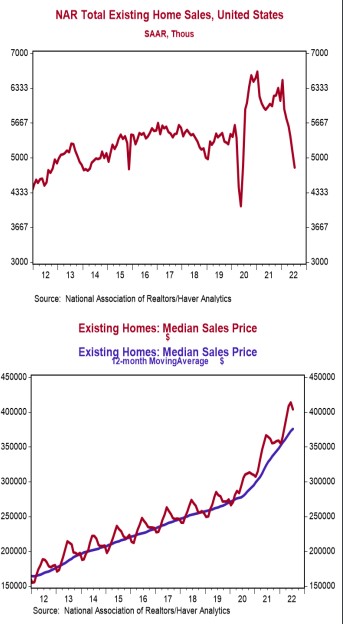- Existing home sales declined 5.9% in July to a 4.810 million annual rate, below the consensus expected 4.860 million. Sales are down 20.2% versus a year ago.
- Sales in July fell in all major regions. The drop was due to both single-family homes and condos/co-ops.
- The median price of an existing home fell to $403,800 in July (not seasonally adjusted) but is up 10.8% versus a year ago.
Implications:
Existing home sales fell for the sixth month in a row in July, posting the longest streak of declines since 2013. Falling affordability is playing a major role, with the prime culprit being the surge in mortgage rates. One piece of good news is that it looks like mortgage rates peaked in June and have fallen since. However, current rates are still hovering near 5.5%, up roughly 200 basis points since December. Median prices also broke a five-month streak of gains in July, falling 2.4%. Part of this is just seasonality (prices typically begin to fall near the end of the summer buying season), but at least buyers aren’t getting squeezed at both ends anymore. Moreover, median price growth in the past year has slowed to 10.8% from a peak of 25.2% in May 2021. Assuming a 20% down payment, the rise in mortgage rates and home prices since December amount to a 43% increase in monthly payments on a new 30-year mortgage for the median existing home. No wonder sales have slowed down! Today’s report also showed that the inventory of existing homes on the market has continued to rise rapidly. Though inventories were flat from a year ago in July (the best way to look at the data given the seasonality of the housing market) this is still a notable improvement following thirty-six straight months of annual declines ending in June. Meanwhile the months’ supply of existing homes for sale (how long it would take to sell today’s inventory at the current sales pace) rose to 3.3 months in July, the highest level in more than two years. While this represents much needed progress, it’s important to note that inventory still remains low from a historical perspective. What is really impressive is that despite the lack of options, demand remains strong, with buyer urgency so high in July that 82% of existing homes sold were on the market for less than a month. While sales are clearly under pressure, this is not a repeat of 2007-09. We do not foresee a widespread collapse in home sales even with higher mortgage rates, though it is likely that existing home sales wind up lower in 2022 than 2021. With more inventory finally becoming available and both median prices and mortgage rates moderating, look for sales to begin stabilizing in the months ahead. In other news this morning, initial unemployment claims fell 2,000 last week to 250,000. Meanwhile, continuing claims rose 7,000 to 1.437 million. These numbers suggest continued job growth in August but not as fast as in the first seven months of the year. Finally, in manufacturing news this morning, the Philadelphia Fed Index, a measure of factory sentiment in that region, rose to +6.2 in August from -12.3 in July.





